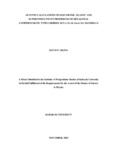AB INITIO CALCULATIONS OF ELECTRONIC, ELASTIC AND SUPERCONDUCTIVITY PROPERTIES OF HEXAGONAL ANTIPEROVSKITE- TYPE CARBIDES XCCr3 (X=Al, Ga or Zn) MATERIALS
Abstract
The positions of the anions and cations are switched in antiperovskites material, which are inorganic compounds with a perovskite-like structure. The family of antiperovskites materials includes insulators, superconductors and semiconductors which make them useful in a variety of technologies such as spintronics, memory devices, transformers, motors, generators and sensors. There has not been enough research done on how magnetism and superconductivity interact. Antiperovskite hexagons' superconducting transition temperatures have not been fully studied. To complement experiments, computational simulations must be developed. The analysis of the superconducting properties in detail, including the superconducting energy gap, electronic structure properties and superconducting transition temperature, was done using a state-of-the-art ab initio approach. The Quantum Espresso Simulation Package was used to run all the calculations. Density functional theory as well as plane wave basis set framework were used for all computations. The electronic structure properties, elastic, superconducting transition temperatures and thermodynamic properties of hexagonal antiperovskite XCCr3 (A=Zn, Ga, or Al) were all calculated using density functional theory in the generalized gradient approximation (GGA). The calculated lattice constants were 5.207Å, 5.813Å and 5.721Å for AlCCr3, GaCCr3 and ZnCCr3 respectively and are in good agreement with the previous available theoretical work. Voigt-Reuss-Hill averaging was used to obtain values for the parameters that make up the elastic constants. From this study, AlCCr3, GaCCr3 and ZnCCr3 were all found to have Poisson's ratios of 0.1114, 0.1153 and 0.094 respectively. Each parameter calculated value was checked against previously established theoretical and experimental norms. The transition temperature of the three materials is investigated so that the electron-phonon interaction may be simulated. Phonon dispersion research confirmed that all three compounds are dynamically stable. The mechanism for superconductivity is the interaction of electrons in the 4d state of Cr with low-frequency phonons. The average electron-phonon coupling value was calculated to be 0.60 for AlCCr3, 0.77 for GaCCr3, and 0.70 for ZnNCr3, yielding superconducting transition temperatures of 6.82 K, 12.01 K and 8.21 K, respectively indicating a moderate amount of electron-phonon coupling strength. The findings show that compared to GaCCr3 and ZnCCr3, AlCCr3 is harder, stiffer, and more tightly bound, and has a Debye temperature that is much higher. However, at lower Debye temperatures, the bonds in GaCCr3 and ZnCCr3 are weaker and the materials are less stiff.

